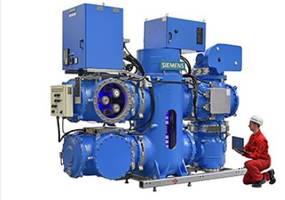Siemens Receives Order for World’s First SF6-Free Gas-Insulated Switchgear with “Clean Air†and Vacuum Switching Technology for 145 kV

Vacuum circuit breakers and “clean air” insulation replace SF6 as switching and insulating medium
SF6-free gas-insulated switchgear (GIS) for 145 kV, 40 kA, 3,150 A
Combination with low power instrument transformers (LPIT) ensures a compact design
Siemens Energy Management received an order from Bergenshalvøens Kommunale Kraftselskap (BKK Nett) in Norway to supply the world’s first SF6-free GIS with “clean air” and vacuum interruption systems for a voltage level of up to 145 kilovolts (kV). The switchgear is part of the Koengen substation in Bergen, which shall supply electricity from renewable energy sources to Norway’s largest cruise ship seaport. Non-conventional systems for measuring current and voltage allow the switchgear to have a much more compact design. The start of the collaboration was celebrated on November 5, 2018, at Siemens' headquarters in Bergen. Commissioning is scheduled for end of 2019.
The number of cruise ships in Norwegian waters is rising continuously. While only 100 ships berthed in the Port of Bergen in 1990, Bergen Havn expects this figure to rise to 300 in 2018. As a result, Norwegian seaports have set themselves the goal of reducing harmful emissions during ship lay times. One measure is to supply more and more ships with shoreside electricity from hydroelectric power. To provide the necessary grid infrastructure to handle higher voltages, the Norwegian energy provider BKK Nett is upgrading its transformer substation in Bergen from a 45 kV to a 132 kV operating level, making it state of the art.
The order includes three bays of the 8VN1 gas-insulated, SF6-free 145 kV switchgear. This GIS uses vacuum interrupters for switching functions and treated air, known as “clean air”, as the insulating medium. It is therefore possible to completely eliminate the use of sulfur hexafluoride. With this project, a gas-insulated switchgear with vacuum interruption systems and “clean air” technology for a voltage of up to 145 kV is being delivered for the first time in the world.
“The large proportion of hydropower in Norway’s power system makes it the world's most climate-friendly system. Now we are investing in a pilot project which uses an environment friendly alternative to SF6 gas, thus becoming the first project of its kind in the world with this technology. Siemens is a solid supplier, and we expect them to develop this technology further,“ said Wenche Teigland, CEO of BKK Nett. The first “clean air” vacuum circuit-breaker and “clean air” instrument transformer went into operation in a German 110 kV high-voltage grid in June 2018. “This order for an SF6-free high-voltage switchgear in Norway demonstrates that our customers are attaching more and more importance to sustainable grid technology,” says Ralf Christian, CEO of the Siemens Energy Management Division. “The SF6-free GIS from our so called “blue portfolio” requires no special precautions to be taken during operation and recycling and offers top technical performance, maximum safety, and reliability. There is also no longer any need to report the quantities of fluorine gas used.”
The ordered 8VN1 GIS features a rated voltage of 145 kV, a rated short-circuit breaking current of 40 kA, and a rated current of 3,150 A. The non-conventional low power instrument transformers (LPIT) used ensure an especially compact design. The switchgear’s size and weight are up to 20 percent less than in a system with conventional current and voltage transformers. The technology also makes it possible to flexibly parameterize the measuring and protective systems according to customer’s specific requirements. Transmitting the data over a fiber-optic cable reduces the amount of wiring, and there is no backup solution with conventional measuring and protection systems used. LPITs are an important step forward in the direction of a digital substation.
SF6-free circuit-breakers and GIS are a further development of the switching and insulation using SF6, which has been proven in practice for years. A vacuum interrupter unit handles the switching and arc-extinguishing functions. Industrially prepared and purified air in a mixing ratio of 80 percent nitrogen to 20 percent oxygen (known as “clean air”) provides the insulation for the current-carrying conductors inside the housing. By combining vacuum interruption systems for switching and for arc extinguishing with “clean air”, Siemens has further developed its existing technology to meet climate neutrality requirements. This switching and insulating technology has zero global warming potential (GWP).
This press release and press pictures are available at
www.siemens.com/press/PR2018110063EMEN
For further information on Division Energy Management, please see
www.siemens.com/energy-management
For further information on the Siemens blue portfolio, please see
siemens.com/eco-transparency
Contact for journalists
Anna Korb
Phone: +49 9131 173 663 7; E-mail: anna.korb@siemens.com
Follow us on Twitter at: www.twitter.com/siemens_press
Siemens AG (Berlin and Munich) is a global technology powerhouse that has stood for engineering excellence, innovation, quality, reliability and internationality for 170 years. The company is active around the globe, focusing on the areas of electrification, automation and digitalization. One of the world’s largest producers of energy-efficient, resource-saving technologies, Siemens is a leading supplier of efficient power generation and power transmission solutions and a pioneer in infrastructure solutions as well as automation, drive and software solutions for industry. With its publicly listed subsidiary Siemens Healthineers AG, the company is also a leading provider of medical imaging equipment – such as computed tomography and magnetic resonance imaging systems – and a leader in laboratory diagnostics as well as clinical IT. In fiscal 2017, which ended on September 30, 2017, Siemens generated revenue of €83.0 billion and net income of €6.2 billion. At the end of September 2017, the company had around 377,000 employees worldwide. Further information is available on the Internet at www.siemens.com.




